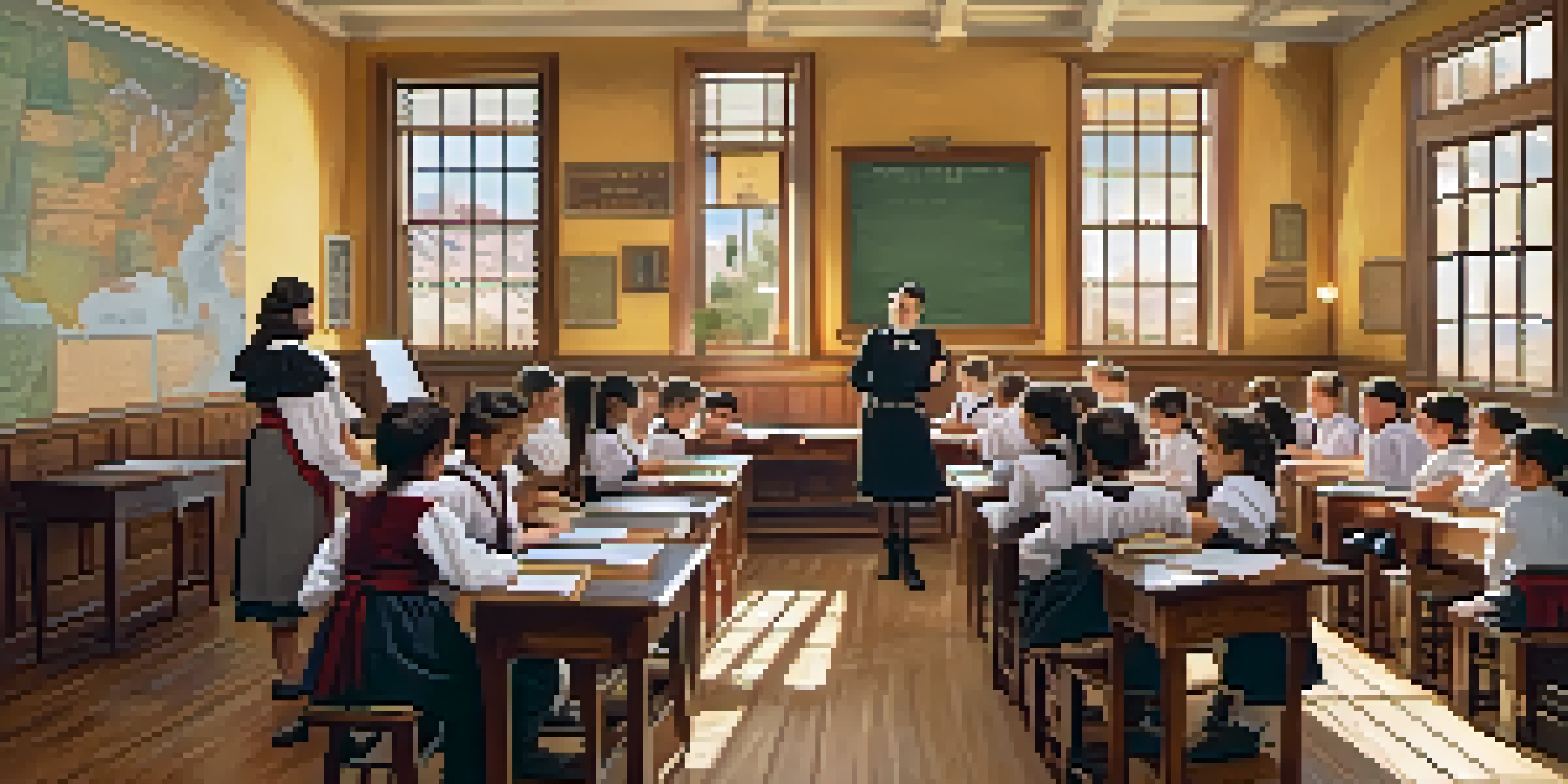The Origins of Education in Arizona: A Historical Overview

The Early Beginnings of Education in Arizona
Education in Arizona can be traced back to the 19th century, when the region was still largely uncharted territory. The first schools were established by missionaries and settlers who saw the need for education among the growing population. These early institutions often focused on basic literacy and religious teachings, laying the groundwork for future educational developments.
Education is the most powerful weapon which you can use to change the world.
In the 1860s, following the establishment of the Arizona Territory, the government began to take a more active role in education. The first public school was opened in 1865 in Tucson, signifying a shift from informal learning to a structured educational system. This transition marked the beginning of organized education in the region, although it was still limited and often unequal.
The influence of the Mexican-American community also played a vital role in shaping early education. Many families prioritized bilingual education, which became a cornerstone for schools in areas with significant Hispanic populations. This bilingual focus not only enriched the curriculum but also fostered cultural awareness and integration.
The Impact of Territorial Legislation on Education
As Arizona grew, so did the need for formal educational policies. The Arizona Territorial Legislature took significant steps in the 1880s to establish a public school system that would serve the burgeoning population. Laws were enacted to create school districts, regulate teacher qualifications, and allocate funding, thus formalizing the education landscape.

One notable piece of legislation was the establishment of the Arizona Territorial Normal School in 1885, which aimed to train teachers for the growing number of schools. This institution was crucial in addressing the demand for qualified educators and set a precedent for future teacher training programs across the state.
Education's Early Foundations in AZ
Arizona's education began with missionaries and settlers, evolving into a structured system with the establishment of public schools.
However, the legislation also highlighted disparities in education, particularly for Native American and minority communities. The limited access to quality education for these groups sparked debates about equity and inclusion that resonate in Arizona's educational discourse even today.
The Role of Native American Education in Arizona
Native American tribes in Arizona have a rich educational heritage that predates European settlement. Traditional methods of teaching and learning were deeply rooted in cultural practices, focusing on community values and survival skills. However, with the arrival of settlers, these practices faced significant challenges and transformations.
The roots of education are bitter, but the fruit is sweet.
In the early 20th century, government policies aimed to assimilate Native American children into mainstream society resulted in the establishment of boarding schools. These institutions often stripped students of their cultural identities, emphasizing English language proficiency and Western education. This era left a complicated legacy that still affects Native American education today.
In recent years, there has been a resurgence of interest in incorporating Indigenous knowledge and languages into the curriculum. Schools are beginning to recognize the importance of culturally relevant education, allowing Native American students to learn in ways that honor their heritage while also preparing them for the future.
The Influence of the Great Depression on Arizona Schools
The Great Depression of the 1930s had a profound impact on education in Arizona, as it did across the United States. Financial strain led to budget cuts, teacher layoffs, and school closures, creating challenges for students and educators alike. Many families struggled to afford basic necessities, let alone educational materials or tuition.
In response to the crisis, the federal government introduced programs such as the Works Progress Administration (WPA) to support public works projects, including the construction of schools. This initiative not only provided jobs but also improved school facilities, allowing for a renewed focus on education during difficult times.
Legislation and Educational Equity
The Arizona Territorial Legislature introduced reforms in the 1880s, but disparities in education access for minority communities highlighted ongoing equity issues.
Despite these efforts, the quality of education varied significantly between urban and rural areas. This disparity highlighted the need for long-term educational reforms that would ensure all students, regardless of their circumstances, had access to quality education.
Post-War Expansion and Educational Reforms
After World War II, Arizona experienced a population boom, leading to an increased demand for education. The influx of new residents and returning veterans necessitated a significant expansion of the school system, resulting in the construction of new schools and the hiring of more teachers. This period marked a turning point in Arizona's educational landscape.
The 1960s and 1970s brought about significant educational reforms aimed at improving access and quality. These reforms included the implementation of special education programs and the introduction of community colleges, which provided opportunities for higher education to a wider audience. This shift marked a move towards inclusivity in the education system.
During this time, the emphasis on multicultural education also began to rise. As Arizona's demographic landscape evolved, schools started to incorporate diverse perspectives and histories into the curriculum, reflecting the rich tapestry of the state's population.
The Rise of Standardized Testing and Accountability
The late 20th century saw the introduction of standardized testing as a means to assess student performance and hold schools accountable. In Arizona, this trend sparked debates among educators and policymakers about the effectiveness and fairness of such assessments. Critics argued that standardized tests often failed to capture a student's true abilities and potential.
In response to these concerns, initiatives like the No Child Left Behind Act were implemented to improve educational outcomes for all students. This legislation aimed to close achievement gaps and promote accountability, but it also faced criticism for placing undue pressure on teachers and students alike.
Modern Challenges in Education
Today, Arizona faces challenges like funding shortages and teacher retention, necessitating innovative solutions to ensure equitable learning for all students.
Despite the challenges, standardized testing has led to increased discussions about educational equity. Schools are now more aware of the disparities in resources and support that exist among different communities, prompting efforts to address these inequalities.
Modern Challenges and Future Directions in Arizona Education
Today, Arizona's education system faces a variety of challenges, including funding shortages, teacher retention issues, and disparities in student achievement. The COVID-19 pandemic further exacerbated these problems, highlighting the need for innovative solutions that can adapt to changing circumstances. Educators and policymakers are working tirelessly to address these pressing issues.
Additionally, there is a growing emphasis on incorporating technology into the classroom. As digital learning tools become more prevalent, schools are exploring ways to enhance student engagement and personalize learning experiences. This shift offers exciting opportunities, but it also requires careful consideration of equity and access.

Looking ahead, Arizona's education system must continue to evolve to meet the needs of its diverse student population. By fostering collaboration among educators, families, and communities, the state can work towards creating an inclusive and equitable educational environment that prepares all students for success.